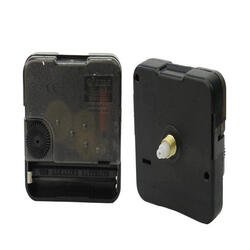Clock Parts

The Modern Clock Mechanism and its Magic
A clock mechanism normally describes the engine of drive force that makes a watch job. "Clock mechanism" is more of a nonprofessional's term; "activity" and also "electric motor" are matchings for the same point and also are closer to trade names. But whatever the term made use of, the capability explained is the instantaneous positioning of hands versus a dial and the behavior of particular other components.
The clock mechanism of today is practically a digital black box, interfacing to the outdoors using predicted concentric round shafts. These shafts rotate individually of one another and the end of each attaches to the hr, min, or previously owned. The black box is likewise affixed to a framework by inserting the threaded estimate with a hole in the center of the dial as well as securing with a nut.
The older way of accomplishing the exact same thing was done mechanically with the drive originating from a dangling weight or coiled springtime. The produced torque (rotational force) triggered the major equipment to rotate slightly, and via a network of linked equipments, turnings of meticulously calculated rates (matching secs, minutes, and also hours) were attained. An adjusted combination of pendulum and escapement prevented freewheeling.
The drive in the contemporary electronic black box version is a quartz crystal that generates a fast pulse stream with a regularity extremely accurate. As opposed to a network of equipments there's a collection of registers that maintain running matters of the pulses. When different mathematical thresholds are gone across the seconds, mins, and/or hrs are incremented.
Thus far we have actually defined the functions of a fundamental clock mechanism. However it can a lot more than basic timekeeping, consisting of displaying more comprehensive temporal cycles, weather sensations, as well as uniqueness functions. In these areas is where the modern activity is seen to be performing something enchanting.
As an example, consider the standard 12-hour cycle in reporting the moment (with hands and also a dial) we are all used to. Why not use a 24-hour cycle (like the armed forces) with twice as lots of numbers spaced along the area of the dial? Indeed, such a device is offered via most clock components suppliers, as well as it merely needs to be adjusted in different ways to move the hands twice as gradually.
Various other time expansions are additionally offered. The cycle is extended to a week or to an even month, and also a 4th hand is used to orient the audience to the appropriate placement. For a weekly cycle, the additional hand points to the day (one of 7 sectors in the facility of the dial); for month-to-month cycles it indicates the date.
The clock mechanism is adjusted to reveal weather sensations by spreading out the scale (temperature, moisture, stress, etc.) circularly around the dial (once more, specially calibrated) and moving the (single) hand to aim at the current value. The black box gets the current worth via a sensing unit, the reading of which is upgraded regularly.
Novelty functions consist of chimes, alarms, as well as pendulums. Such attributes are developed straight into the mechanism. Chimes as well as alarm systems come with numerous alternatives and user interface switches, whereas an oscillating tab supplies the clockmaker with a way to attach a cosmetic-only pendulum that emulates the actions of a genuine one.
The majority of mechanisms are battery powered, either with a C cell or AA cell. However, some featured a cable that plugs into an electric outlet, either along with the battery (for backup purposes) or rather than it. Sometimes suppliers offer a solar alternative.
We have discussed the main concerns one needs to recognize to build wrist watches from the ground up. The viewers must now value the contemporary clock mechanism as well as its magic. quartz clock mechanismquartz clock mechanism



